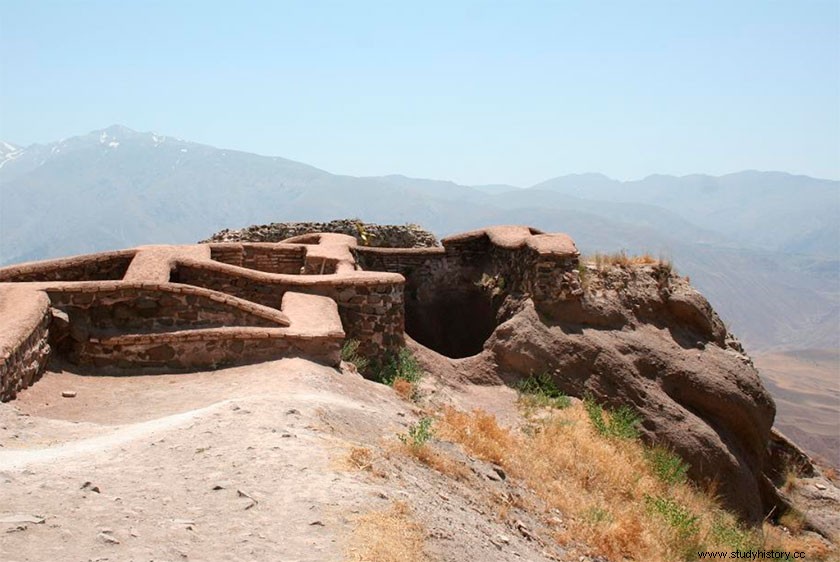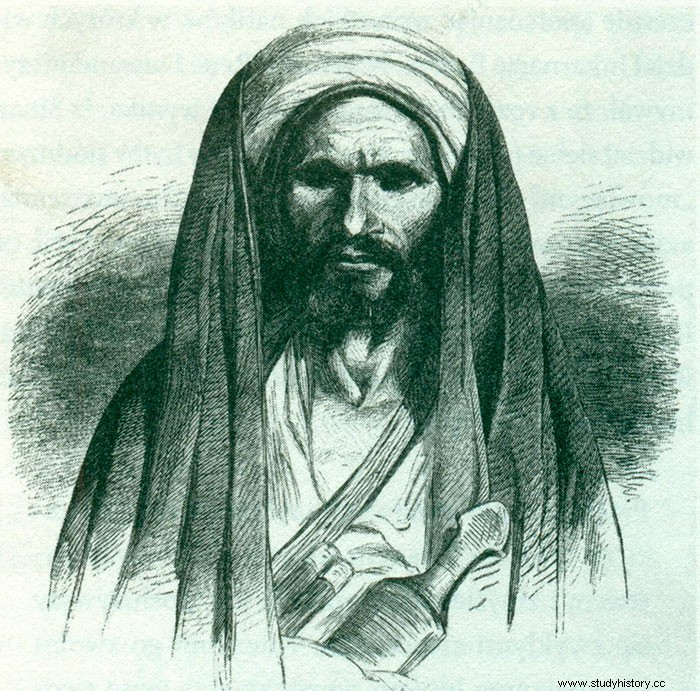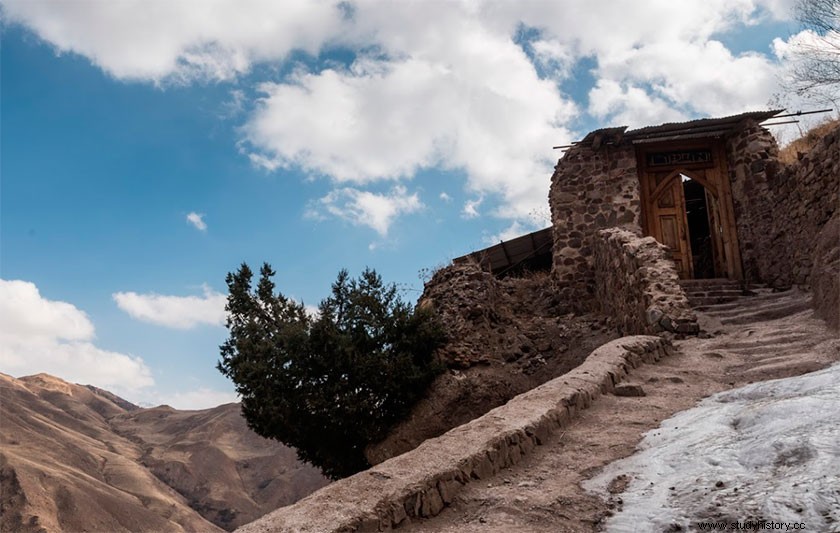
We are heading to the Elbruz mountains, the natural border to the northern Iran between the Caspian Sea and the Iranian Plateau. To discover the remains, located more than 2,000 meters above sea level, of what was one of the most mysterious and, at the same time, fearsome places in the entire Middle Ages. The mythical Alamut fortress , conquered at the end of the 11th century by the so-called “sect of the assassins ”, and rebuilt to become its headquarters.

The remains of the Alamut fortress
The Nizaríes.
We can say that it is the name of the Nizaríes, it is the one that history has assigned to this sect of assassins, half legend, half reality.
But to get to know them a little better we must go back to the early days of Islam, after the death of Mohammed in the year 632, succession struggles took place. On the one hand, the supporters of Ali ibn Abi Talib, Muhammad's son-in-law after marrying Fatima, the prophet's daughter, from then on known as Shiites. On the other, the rest, called Sunnis, descendants of the tribes of Mohammed. While the former legitimized their position as heirs of the prophet, the latter relied on the tribal condition of succession, it becomes clear that the Sunnis will always be a majority over the Shiites.
Despite internal disputes, Islam spread very rapidly in the following years. Fact that led to the conversion of the new conquered peoples, among them, for example, the ancient Persians who added their ancient Zoroastrian beliefs to Islam. This aspect was not well received by orthodox Sunnis, so the new converts, apart from approaching Shiite positions, will begin to meet secretly to preserve their oldest traditions. After which, the latter and their adaptation to the Koran left by Muhammad, will lead to the birth of secret groups that will achieve high levels of power in the Islamic world.

Kairouan Mosque, the first capital of the Shiite Fatimid dynasty
The key to these groups seems to be that it was in the high intellectual and educational level they acquired, a fact that allowed them to travel through the Islamic territories, continually uniting faithful to the Shiite cause. Although specifically to a new branch of Shiism known as the Ismaelis. His coming to power occurs in the year 909, after the conquest of the territories of present-day Tunisia and the establishment of the Fatimid dynasty, the capital chosen for it Kairouan.
The arrival of the Nasrids in Alamut.
The Fatimid dynasty will eventually conquer much of the Islamic territories, especially in North Africa and a large coastal strip of the Arabian Peninsula. Years later a new dynasty will come to join forces with the Shiite cause, the Buyids, originating precisely from the area of our protagonist, the fortress of Alamut, and who will take control of one of the capitals of Islam, Baghdad. Both took Shiism to the time of greatest control of Islam, which this branch has had throughout its history.
But as we have already mentioned, Sunnism was always in the majority and a new dynasty will come to corroborate it, in this case the northern neighbors and new converts, the Seljuq Turks. Which in the year 1055 will again take control of one of the capitals of Islam, Baghdad. This fact, together with the breeding ground of the three centuries of religious disputes, was the environment that a young Persian student found upon his arrival in El Cario, his name Hasan Sabbah, the founder of the sect of the assassins .

Hassan Sabbah
After his training in the ancient Ismaili traditions in the Shiite capital of Islam, a Cairo, come to less by various economic crises. Hasan Sabbah began a new recruitment of faithful, which led him to take the fortress of Alamut in the year 1090, making it the headquarters of the Nizaríes sect. By the way, when our character takes the fortress, he is no longer that young student but "the old man of the mountain" or "the lord of the daggers". Despite this last name, it is said that the taking was not by force, but thanks to persuasion, deception, and the great skills of the members of this sect. The truth is that from that moment they began their particular fight to put an end to the enemies of the most radical Shiism, but far from wars and with very particular methods.

The remains of the fortress are a very visited place in present-day Iran.
The victims of the assassin sect.
It is clear that the first victim, at least important, was a Sunni leader, specifically the vizier Nizam al-Mulk , known for being the driving force behind the administrative reforms that organized the new Seljuk Empire. His murder is shrouded in legend and reality, it is said that in the middle of a trip between the cities of Baghdad and Isfahan, a member of the sect of assassins He ended his life, after stabbing him with his dagger.

Nizam al-Mulk
The conjectures begin when trying to find a promoter of said assassination, since many eyes point to the sultan Malik Shah I , in power at the time, the cause that is usually turned to, jealousy for the power of the assassinated vizier. But the story does not end here, since a month later the sultan is found dead in his bed, after being the victim of poisoning, the culprit seems to be one of his servants, the hidden hand is from the sect of the assassins. The consequences seem to justify the path of those who bet on the Nizaríes de Alamut , not in vain both murders led to the end of the Seljuks in the Middle East, by producing a great fragmentation.
The following significant victims of the Assassin's cult they will come from the Christian side. Despite the fact that, in the end, great agreements were reached between the warriors of Christ, embodied mainly by the Templar and Hospitaller orders, the road to them was not without obstacles. The first of the Christian victims that we have in mind was the Count of Tripoli Raymond II , the motives as in a large part of those murdered by the sect, a mystery, although there is speculation about the disagreements with his wife, who will eventually take control of the county. But the Knights Templar are also suspected, since after the death of Raimundo II they will become owners of some fortresses guarded by the Hospitallers, those preferred by the murdered Count.
But without a doubt the most famous of the Nizaríes victims is Conrado de Montferrato , king of Jerusalem, for a few days. His marriage of convenience to the heiress to the throne, Elizabeth of Jerusalem, elevated him to such a coveted position. Despite the fact that the holy city had already fallen into Muslim hands a few years earlier and the Christians controlled only a small strip near the Mediterranean, it remained a place of honor among the Christian kings.
Returning to the character of Conrad I, the position lasted less than a week, since he was killed by two Nizaris while returning home. One of them taken prisoner blamed the English king Richard the Lionheart, according to the murderer to return the royal post to his protégé Guido de Lusignan. Fact that was never proven, and this served for different conjectures, including that it had been ordered by Saladin, the new Muslim king of Jerusalem.
The fall of the fortress of Alamut.
There were many murders that the sect of assassins carried out in its nearly two centuries of history, but one of them seems to be that it will affect it at the beginning of its decline. In 1241 Genghis Khan's second son, Chagatai, who inherited the territories closest to Islam from his father, died. There is no evidence, but the Nizaris are blamed. A few years later, Hulagu, Genghis Khan's grandson and therefore Chatagai's nephew, decides to take revenge on the sect of assassins. It is said that the army he assembled was one of the largest in the history of the Mongols, its purpose was to put an end to the sect of the assassins, to have a free hand and conquer the dying Abbasid Empire of Baghdad.

A place at first sight difficult to conquer.
It seems that the Nizaris were able to exert little resistance against the Mongol hosts, the then leader of the sect of the assassins, Rukn al-Din handed over Alamut in exchange for the surrender of the. But Hulagu was not satisfied, he razed the fortress and with it one of the best libraries of the Middle Ages, it was the year 1256.
Although it is clear that this was not the end of the sect, the survivors dispersed throughout Islam and it is well known that they continued to commit selective assassinations, one of which could have been Edward I from England, which narrowly escaped.
Fables, stories and literature about the Nizaris.
After the exposition of the story it is clear that the sect of the assassins , is once again one of the many stories of the Middle Ages, on the way between fiction and reality. Much has been written about them, some sources say that to recruit people the Nizari leaders used the same drugs as their subjects to commit the murders.

The mythical fortress in the eyes of the creators of Assasin's Creed
The first to transmit his story to Europeans was Marco Polo, although it seems that he must have known it rather through others, since the stay cannot be true of him in Alamut. It is necessary to remember that the greatest traveler of the Middle Ages was born in 1254 and his journey to Asian lands began in 1271, years after the end of Alamut. But the clearest reference to the Alamut killers came to us in 1938 with Vladimir Bartol's sensational novel Alamut. By the way and to conclude, inspired by one of the video games that have caused the most sensation in recent years, Assassin's Creed.

The entrance to the fortress today.
More info:Alamut, Vladimir Bartol, 1938
Images:commons.wikimedia
